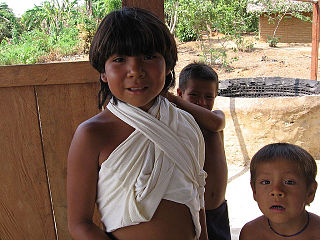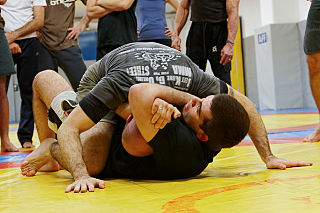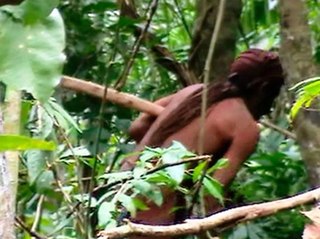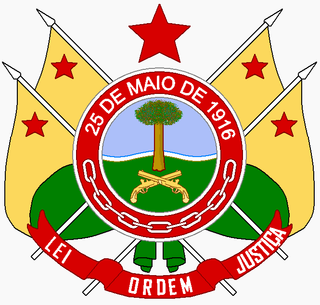
The Indigenous peoples in Brazil are the peoples who lived in Brazil before European contact around 1500 and their descendants. Indigenous peoples once comprised an estimated 2,000 district tribes and nations inhabiting what is now Brazil. The 2010 Brazil census recorded 305 ethnic groups of Indigenous people who spoke 274 Indigenous languages; however, almost 77% speak Portuguese.
Orlando (1914–2002) and his brothers Cláudio (1916–1998) and Leonardo Villas-Bôas (1918–1961) were Brazilian brothers who worked in indigenous activism. In 1961 they succeeded in getting the entire upper Xingu legally protected, making it the first massive indigenous area in all South America, and the prototype for dozens of similar reserves all over the continent.

Terra indígena Raposa/Serra do Sol is an indigenous territory in Brazil, intended to be home to the Macushi people. It is located in the northern half of the Brazilian state of Roraima and is the largest in that country and one of the world's largest, with an area of 1,743,089 hectares and a perimeter of about 1,000 kilometres (620 mi).

The Fundação Nacional dos Povos Indígenas or FUNAI is a Brazilian governmental protection agency for Amerindian interests and their culture.

The Kamayurá are an indigenous tribe in the Amazonian Basin of Brazil. Their name is also spelled Kamayura and Kamaiurá; it means "a raised platform to keep meat, pots and pans." The Kamayurá language belongs to the Tupi–Guarani family.
The Akuntsu are an indigenous people of Rondônia, Brazil. Their land is part of the Rio Omerê Indigenous Territory, a small indigenous territory which is also inhabited by a group of Kanoê. The Akuntsu were victims of a massacre perpetrated by Brazilian cattle ranchers in the 1980s and currently number just three individuals. It is unlikely that the Akuntsu language or culture will survive after their deaths, leading several observers to describe them as victims of genocide.
The Xingu Indigenous Park is an indigenous territory of Brazil, first created in 1961 as a national park in the state of Mato Grosso, Brazil. Its official purposes are to protect the environment and the several nations of Xingu Indigenous peoples in the area.
The Aweti people are a group of Indigenous Brazilians living in the Xingu Indigenous Park, close to the headwaters of the Xingu River in Brazil. The Aweti inhabit two villages in the region. One is called Tazu’jyretam, and the other is unnamed. Tazu’jyretam is the main village of the Aweti people, and has been inhabited since at least the 19th century. Tazu’jyretam also has a small port. Both of these villages are located in an area between the Curisevo and Tuatuarí rivers, which feed into the Xingu further upstream. Their population was 196 in 2011, up from 140 in 2006.

Yamurikuma is a female spirit who represents the ancestral women of the indigenous Wauja people. The Wauja people are located at South America, in the Upper Xingu River, Brazil. Wauja people have celebrated Yamurikuma in rituals, ceremonies, and traditions for centuries. Shamans in Xingu villages call women specifically to perform sing and song rituals for the female spirit Yamurikuma and the deceased or terminally ill Xingu people. It is one of the only exceptions made for the women in these communities to lead a ritual. Yamurikuma is also celebrated in a festival named after the spirit herself. This festival is organized by the Xingu Tribes, and throughout this specific festival, the Xingu women take on the male roles of the tribe for a week.
Jean-Pierre Dutilleux is a Belgian author, activist, film director, actor and editor of films.

In Brazil, an Indigenous territory or Indigenous land is an area inhabited and exclusively possessed by Indigenous people. Article 231 of the Brazilian Constitution recognises the inalienable right of Indigenous peoples to lands they "traditionally occupy" and automatically confers them permanent possession of these lands.
The Uru-Eu-Wau-Wau are an indigenous people of Brazil, living in the state of Rondônia.

The Araweté are an indigenous people of Brazil. They are swidden horticulturalists native to the state of Pará.

Luta Livre, known in Brazil as Luta Livre Brasileira or Luta Livre Submission, and also Brazilian Submission Wrestling, is a Brazilian martial arts and combat sport created by Euclydes Hatem in Rio de Janeiro. Primarily a mixture of catch wrestling and kosen judo, there is also ground striking with the hands, feet, knees and elbows. Notable practitioners include Marco Ruas, Ebenezer Fontes Braga, Johil de Oliveira, Alexandre Franca Nogueira, Renato Sobral, Gesias Cavalcante, Pedro Rizzo, Darren Till and José Aldo.

The Man of the Hole, or the Tanaru Indian, was an Indigenous person who lived alone in the Amazon rainforest in the Brazilian state of Rondônia. He was the sole inhabitant of the Tanaru Indigenous Territory, a protected Indigenous territory demarcated by the Brazilian government in 2007.
The Sawré Muybu Indigenous Territory, also called the Daje Kapap Eipi, is an indigenous territory of Munduruku people in the state of Pará, Brazil. It includes land that is sacred to the Mundurukus. Issuance of the document that delimits the territory was delayed until April 2016 because of the problems recognition would create with the proposed São Luiz do Tapajós Dam, which would flood part of the area. As of November 2016 the territory had still not been formally created by decree.

Sônia Bone de Souza Silva Santos, usually known as Sônia Guajajara, is a Brazilian indigenous activist, environmentalist, and politician. A member of the Socialism and Liberty Party (PSOL), she was initially a candidate for President of Brazil in the 2018 Brazilian general election, before being chosen as the vice presidential running mate of nominee Guilherme Boulos. This made her the first indigenous person to run for a federal executive position in Brazil. In 2022, Guajajara was named one of the 100 most influential people in the world by Time.

The Military Police of Acre State are the preventive police force of the state of Acre. In Brazil, Military Police are reserve and ancillary forces of the Brazilian Army, and part of the System of Public Security and Brazilian Social Protection. Its members are called "State Military" person.

Tuíre Kayapó, also called Tuíra, was a Brazilian indigenous rights activist, environmentalist, and a chief of the Kayapó people. She was active in the movement against the Bela Monte Dam project on the Xingu River in the 1980s and constitutional amendment PEC 215 in the 2010s.
The Trincheira/Bacajá Indigenous Territory is an indigenous territory located in the Brazilian state of Pará. Regularized and traditionally occupied, it has an area of 1,650,939 hectares and a population of 746 people (2010), primarily from the Araweté and Asurini peoples of the Xingu.











